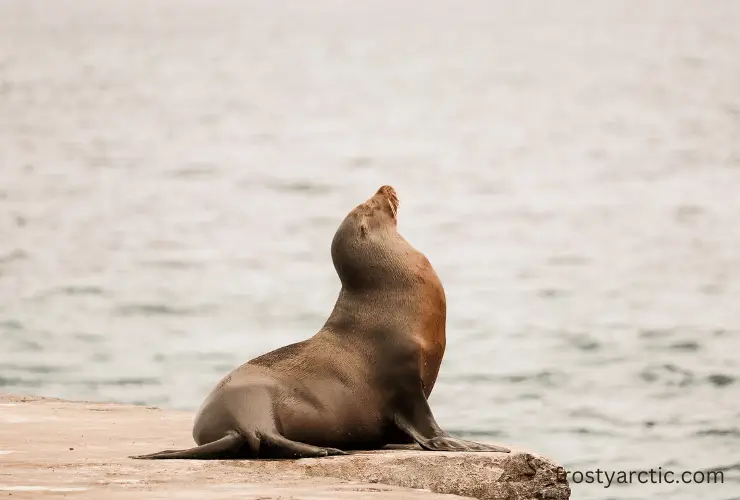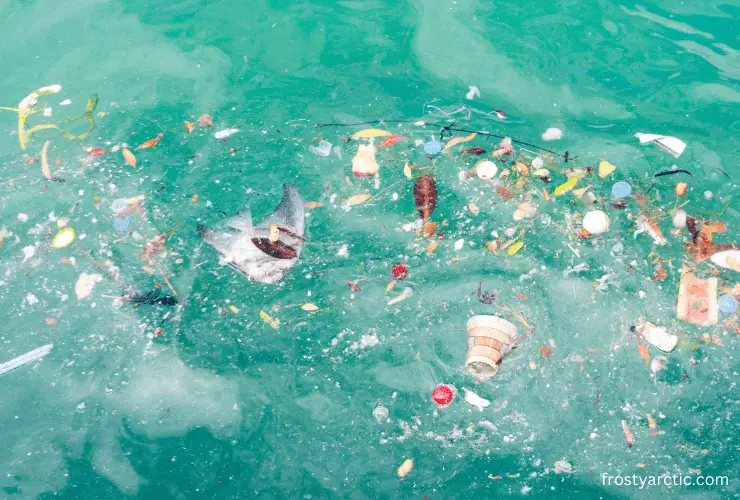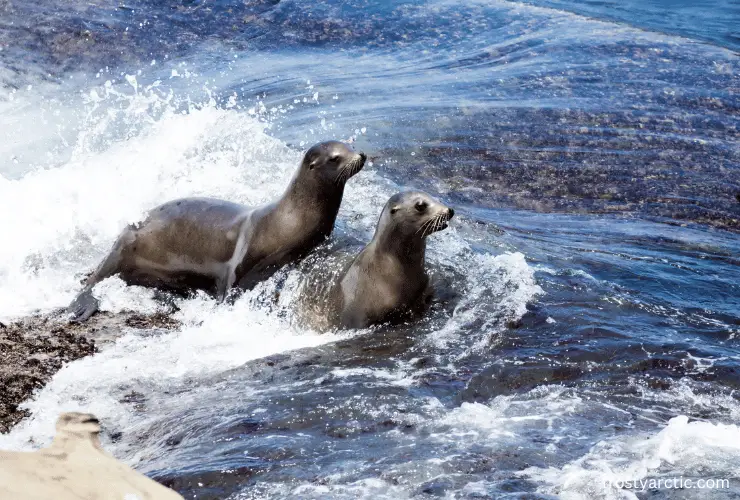Yes, several species of sea lions are classified as endangered, such as the Australian, Galapagos, and New Zealand sea lions. Japanese Sea lions (Zalophus japonicus) are listed as an extinct species. Also, the Steller sea lion is still considered threatened or at risk.
However, it’s essential to note that not all sea lion species are endangered. Some species have stable populations and are not currently at risk of extinction.
The enchanting world of sea lions, with their charming personalities and playful behaviors, captivates the hearts of many. However, amid the wonder lies a growing concern for their survival. The question looms: are sea lions endangered?
In this exploration, we examine sea lions’ challenges in their natural habitats and their urgent need for protection. Join us as we unravel the complexities surrounding conserving these magnificent “dogs of the sea.”
3 Different Sea Lion Species – Endangered and Extinct?

3 different sea lion species are regarded as in danger of extinction. Let’s check out:
Australian Sea Lion (Neophoca Cinerea)
The Australian sea lion (Neophoca cinerea) is a genetically isolated species that inhabits the coasts of Western and South Australia. Around 6,500 mature individuals are left, and their numbers are declining.
The International Union for Conservation of Nature (IUCN) has classified this species as endangered. It is also protected at the state level within its existing range in Australia. The Australian sea lion faced heavy hunting pressures in the past for its fur, leading to a significant decline in its population.
Although hunting has ceased, the species still faces threats, such as habitat degradation and human disturbance. Additionally, accidental entanglement in fishing gear poses a significant risk to their survival.
Conservation efforts for the Australian sea lion involve monitoring their populations and implementing protective measures at critical breeding sites. Also, collaborating with the fishing industry to reduce interactions and accidental bycatch.
Galápagos Sea Lion (Zalophus wollebaeki)
The Galápagos sea lion (Zalophus wollebaeki) is native to the Galápagos Islands in the Pacific Ocean. It is a unique species that plays a crucial role in the island ecosystem. The Galápagos sea lion was historically hunted to near extinction for its fur in the early 20th century.
Thankfully, it is now fully protected under Ecuadorian law, allowing its population to recover over time. Despite its recovery, the Galápagos sea lion remains endangered (under criteria A2ab), as classified by the IUCN since 2008 (Source). It’s possible that El Nio events can affect food availability and breeding success, which can threaten their conservation.
For instance, the species experienced a decline of almost 24% following a severe El Niño event in 2015. The Galápagos Islands are protected from disturbances as part of the conservation program. Also, strict regulations are enforced to prevent disruptions to sea lion colonies.
New Zealand Sea Lion (Phocarctos hookeri)
The New Zealand sea lion (Phocarctos hookeri) is a critically endangered species found on the subantarctic islands of New Zealand. The IUCN added it to the endangered list in 2015 after determining a 98% likelihood of extinction within five generations.
At the time of the assessment, slightly over 3,000 individuals were remaining in total. Historical hunting and habitat loss contributed to their decline. They face additional threats from fishing gear entanglement and breeding site disturbances.
By working with the fishing industry to reduce bycatch, New Zealand’s sea lion conservation efforts include strict monitoring.
Steller Sea Lion (Eumetopias jubatus): Are Steller sea lions extinct or endangered?
The Steller sea lion (Eumetopias jubatus) is an interesting case as its conservation status varies between different authorities. The discrepancy arises due to variations in population trends in different regions.
While some subpopulations of Steller sea lions have shown significant increases, particularly the Loughlin subpopulation, between 1985 and 2015, other populations have not experienced similar recoveries.
According to the Endangered Species Act of 1990, the USA authority listed the Steller Sea Lion as threatened.
According to the COSEWIC assessment and status report, the Steller Sea Lion is listed as endangered in the western portion of the USA. The status was recorded under the US Endangered Species Act (NMFS 2008).
On the other hand, the US Authority delisted sea lion species in the eastern zone in 2013 because of new breeding sites and increased population. Now, they are not enlisted under CITES.
[CITES -Convention on International Trade in Endangered Species]
Special Concern: Steller Sea Lions are protected under the Marine Mammal Protection Act USA. Overall, the Steller sea lion is still considered at risk, and conservation efforts continue to focus on monitoring and protecting this species throughout its range.
Why are Sea Lions Endangered? 10 Reasons Explained!

Sea lions are endangered due to various factors, including habitat loss, fishing interactions, pollution, and climate change. As a result, their natural environment is disrupted, food availability decreases, and entanglement in fishing gear increases. All these factors contribute to the sea lion species.
Now let’s get into the details:
01. Habitat Destruction
One of the primary reasons for the decline in sea lion populations is habitat destruction. Urbanization, coastal development, and human activities near their breeding and feeding grounds can also disrupt their natural habitats. Furthermore, destroying coastal areas can lead to the loss of sea lion breeding beaches and haul-out sites.
02. Bycatch
The endangered Australian sea lion, mainly, is highly vulnerable to bycatch. These sea lions are attracted to the bait material used in rock lobster pots, which makes them more likely to get caught in the gear.
In particular, young pups are at risk as they may not have the strength or experience to escape. Because of this, they can drown inside lobster pots, leading to significant mortality.
Addressing bycatch is critical for conserving sea lions and other non-target species. Fishermen, scientists, and conservation organizations must work together to mitigate the impact of bycatch on sea lion populations.
03. Climate Change
The impact of climate change on ocean conditions and the availability of primary food sources threatens all sea lion species. Warming temperatures associated with climate change can lead to weakened ocean currents that affect the abundance and distribution of fish prey in sea lion habitats.
Over the past three decades, researchers have found alarming effects of ocean warming in the Gulf of California. Between 1991 and 2019, researchers observed a staggering 65% decline in the sea lion population in the region. This decline was directly linked to the warming of the waters in the Gulf of California.
A study on San Miguel Island off Santa Barbara found that sea lion pup weights decreased during El Nio events. For sea lions, these events disrupt the spawning times and locations of important fish species such as sardines and anchovies.
There has been an alarming increase in stranded and underweight sea lion pups since 2016. The decline in the availability of high-calorie sardines and anchovies, which contain fat essential for sea lion pups, was attributed to this trend.
Instead, nursing female sea lions ate fish with lower fat and calorie content, such as market squid and rockfish. Due to this, pup weights were reduced, and sea lion populations could suffer long-term negative consequences.
04. Pollution

Ocean pollution poses significant threats to sea lions and many other coastal marine animals. As top predators, sea lions are particularly susceptible to pollution or harmful algae blooms that accumulate toxins. These toxins can indirectly affect sea lions by harming the smaller prey species they feed on. These toxins move up the food chain, concentrating on sea lions’ bodies.
However, one of the major contributors to ocean pollution is plastic waste. Sea lions and other marine life can ingest microplastics, which harm their digestive systems.
In fact, oil spills pose a significant danger to sea lions, with Steller sea lions being particularly vulnerable.
In British Columbia, Steller sea lions ranked fourth among vulnerable species to oil spills, highlighting the severity of the threat. Further, scientists discovered in 2021 that a mysterious cancer has afflicted California sea lions for four decades. Toxic chemicals from industrial trash, pesticides, and oil refinery waste cause cancer. (Source)
As a result of these poisonous substances, sea lions’ immune systems weakened, causing cancerous tumors and posing a danger to their survival.
05. Human Disturbance
Tourist activities, boating, and other human disturbances in sea lion habitats can cause stress and disrupt their natural behaviors. Pups can be abandoned or separated from their mothers if disturbed. Also, adults may avoid critical feeding and resting areas.
06. Disease
Sea lion populations suffer devastating effects from spreading diseases, particularly in specific subpopulations. Due to their proximity, they are more susceptible to epidemics because of the transmission of diseases.
One example of a sea lion disease outbreak occurred in the Auckland Islands. In 1998, 2002, and 2003, the subpopulations of New Zealand sea lions experienced epizootic outbreaks, leading to significant early pup mortality rates.
During these outbreaks, the mortality rates were reported to be 50%, 33%, and 21% in the respective years. Several years ago, a serious respiratory disease caused by Klebsiella pneumoniae was the cause of the outbreak. This disease outbreak may have long-term consequences for the affected subpopulations.
San Cristobal, Santa Cruz, and Isabela islands were also impacted by a viral canine distemper outbreak. The disease outbreak raised concerns about its potential transmission to Galapagos sea lions. It was recommended that all dogs on the islands be vaccinated to reduce the risk of spreading the disease to sea lions.
07. Predation
Some natural predators, like sharks and killer whales, can take a toll on sea lion populations, especially on vulnerable pups.
08. Illegal Hunting
In some regions, illegal hunting or poaching of sea lions still occurs for their fur, meat, or other body parts, further endangering their populations.
09. Low Reproductive Rates
Sea lions typically have low reproductive rates, with females giving birth to only one pup at a time and several years between pregnancies. This slow reproductive rate makes it challenging for populations to recover quickly from declines.
What Is the Rarest Sea Lion?
The New Zealand Sea Lion is one of the rarest sea lion species in the world.
Historically, the New Zealand Sea Lion faced extensive hunting for its fur and oil, which led to a significant decline in its population. Today, it continues to face threats from habitat loss, fishing-related mortality, and disturbances at its breeding sites.
Several conservation efforts are underway to protect and preserve the New Zealand Sea Lion, including establishing marine reserves. Even so, the species remains critically endangered, underscoring the urgency of conservation measures. \
How Many Australian Sea Lions Are Left?
According to estimates, there are about 12,000 Australian sea lions (Neophoca cinerea). Only approximately 6,500 individuals out of this total population were considered mature. A significant portion of the population comprises young individuals who still need to be of reproductive age.
However, the fact that only around 6,500 mature individuals exist is a concerning sign for the species’ future. As mature individuals reproduce and contribute to the next generation, they are essential for the population’s long-term viability. As its population declines and adult individuals become fewer, the Australian sea lion faces threats to its genetic diversity.
How Can We Save Sea Lions? What Conservation Actions Have Been Taken?

To save sea lions, we need a comprehensive and multi-faceted approach to addressing their numerous threats. Here are some key conservation actions that have been taken to protect sea lions:
Remove Plastic and Debris
60% of the world’s coral reefs are declining or dead due to plastic and marine debris. Urgent action is needed as this debris poses environmental and health risks. Approximately 8 million tons of debris each year end up in the ocean.
With generous donations, Project Peril and Love the Sea have cleaned over 250,000 feet of beach in Hawaii, highlighting the importance of responsible waste management and protecting marine ecosystems. Collaborative efforts can create a cleaner, healthier aquatic environment for the future.
Marine Protected Areas (MPAs)
Protecting sea lion habitats requires creating and managing marine protected areas. MPAs protect sea lions from human disturbance during breeding, resting, and foraging. Moreover, these protected areas protect sea lions’ habitat and marine ecosystems.
Fishing Regulations and Bycatch Mitigation
Fishing regulations can reduce the accidental entanglement of sea lions in fishing gear (bycatch). In critical sea lion areas, fishing can be closed during the season, and catch limits can be implemented.
Habitat Restoration and Conservation
Efforts to restore and conserve coastal habitats are crucial for sea lion populations. We need to protect and restore sea lion nesting and resting sites and preserve foraging grounds.
Public Awareness and Education
Raising public awareness about sea lions and their conservation status is essential. Educating local communities, tourists, and fishermen about the importance of protecting sea lions is important.
Research and Monitoring
Research and monitoring provide valuable data on sea lion populations and behavior. Conservation strategies can be tailored by understanding their movements, reproduction patterns, and the effects of human activities.
Collaborative Efforts and International Cooperation
It is often necessary to cooperate across national boundaries to conserve sea lions. Governments, NGOs, and international organizations must collaborate to save sea lions and their ecosystems.
Conservation Funding and Support
Conservation initiatives need financial support to be implemented and sustained. People, governments, and donors can support conservation organizations that protect sea lions.
By combining these conservation actions and fostering a collaborative and holistic approach, we can work towards securing a better future for sea lions and the marine environments they inhabit. Continuous efforts, adaptive management, and public support are vital to ensuring the long-term survival of these charismatic marine mammals.
Frequently Asked Questions (FAQs)
Does Japan have sea lions?
Japan’s native sea lion species, the Japanese Sea Lion (Zalophus japonicus), is extinct. Historically, it was found along Japan’s coastlines. But it no longer exists in the wild due to overhunting and habitat destruction.
Are Japanese Sea Lion (Zalophus japonicus) endangered?
Since the 1970s, this Japanese species has been considered endangered. However, now they are listed as an extinct species. The reasons for its extinction include overhunting of fur and meat, habitat destruction, and human disturbance.
Why save sea lions?
Saving sea lions is vital for maintaining marine ecosystem balance. They play a crucial role as top predators, helping control prey populations. Additionally, they serve as indicators of ocean health. Conserving sea lions helps preserve biodiversity and the overall health of marine environments.
What are sea lions scared of?
Sea lions are generally wary of predators, including sharks and killer whales. They are also cautious of approaching boats or humans in their natural habitat. A sudden loud noise, disturbance, or unfamiliar object can startle them.
Sum Up
While not all sea lion species are endangered, the Australian, Galapagos, and New Zealand Sea Lions face significant threats. A changing climate, habitat loss, pollution, and fishing interactions highlight the need for conservation. Together, we can promote awareness, implement proactive measures, and work to protect them.
However, It is crucial to protect sea lions and their habitats not only for the species’ survival, but also for the health of marine ecosystems. So, we are responsible for securing a thriving marine environment for future generations as stewards of the oceans.



1 thought on “Are Sea Lions Endangered, Threatened or Extinct?”